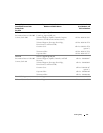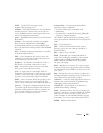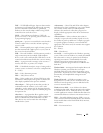
158 Glossary
KB — Kilobyte(s); 1024 bytes.
Kbps — Kilobit(s) per second.
KBps — Kilobyte(s) per second.
key combination — A command requiring you to press
multiple keys at the same time (for example,
<Ctrl><Alt><Del>).
kg — Kilogram(s); 1000 grams.
kHz — Kilohertz.
KMM — Keyboard/monitor/mouse.
KVM — Keyboard/video/mouse. KVM refers to a switch
that allows selection of the system from which the video
is displayed and for which the keyboard and mouse are
used.
LAN — Local area network. A LAN is usually confined to
the same building or a few nearby buildings, with all
equipment linked by wiring dedicated specifically to the
LAN.
lb — Pound(s).
LCD — Liquid crystal display.
LED — Light-emitting diode. An electronic device that
lights up when a current is passed through it.
LGA — Land grid array. A type of microprocessor socket.
Unlike the PGA, the LGA interface has no pins on the
chip; instead, the chip has pads that contact pins on the
system board.
Linux — A UNIX-like operating system that runs on a
variety of hardware systems. Linux is open source
software, which is freely available; however, the full
distribution of Linux along with technical support and
training are available for a fee from vendors such as
Red Hat Software.
local bus — On a system with local-bus expansion
capability, certain peripheral devices (such as the video
adapter circuitry) can be designed to run much faster than
they would with a traditional expansion bus. See also bus.
LVD — Low voltage differential.
m — Meter(s).
mA — Milliampere(s).
MAC address — Media Access Control address. Your
system’s unique hardware number on a network.
mAh — Milliampere-hour(s).
Mb — Megabit(s); 1,048,576 bits.
MB — Megabyte(s); 1,048,576 bytes. However, when
referring to hard-drive capacity, the term is often rounded
to mean 1,000,000 bytes.
Mbps — Megabits per second.
MBps — Megabytes per second.
MBR — Master boot record.
memory address — A specific location, usually expressed
as a hexadecimal number, in the system’s RAM.
memory module — A small circuit board containing
DRAM chips that connects to the system board.
memory — An area in your system that stores basic system
data. A system can contain several different forms of
memory, such as integrated memory (ROM and RAM)
and add-in memory modules (DIMMs).
MHz — Megahertz.
mirroring — A type of data redundancy in which a set of
physical drives stores data and one or more sets of
additional drives stores duplicate copies of the data.
Mirroring functionality is provided by software. See also
guarding, integrated mirroring, striping, and RAID
.
mm — Millimeter(s).
ms — Millisecond(s).
MS-DOS
®
— Microsoft Disk Operating System.
NAS — Network Attached Storage. NAS is one of the
concepts used for implementing shared storage on a
network. NAS systems have their own operating systems,
integrated hardware, and software that are optimized to
serve specific storage needs.
NIC — Network interface controller. A device that is
installed or integrated in a system to allow connection to a
network.
NMI — Nonmaskable interrupt. A device sends an NMI
to signal the processor about hardware errors.
ns — Nanosecond(s).


















